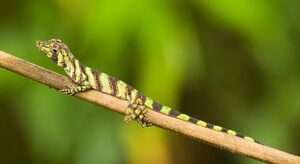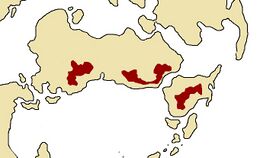Anolis clavoviridis
| Hatched Forest Anole | |
|---|---|

| |
| Anolis clavoviridis | |
| Scientific classification | |
| Kingdom: | Animalia
|
| Phylum: | Chordata
|
| Class: | Reptilia
|
| Order: | Squamata
|
| Family: | Dactyloidae
|
| Genus: | Anolis
|
| Species: | A. clavoviridis
|
| Binomial name | |
| Anolis clavoviridis | |

| |
| Range of A. clavoviridis in Inyursta | |
Anolis clavoviridis, common name: Hatched Forest anole, is a species of anole lizard found in jungle habitats in the Inyurstan subregions of Marindino and Borasoles. Other names include the Olive Banded anole and Banded Forest lizard. Found largely in the understory and canopy of trees, this species is one of many endemic to the Marindanoan Rainforest ecosystem of central Inyursta.
Life History
Hatched Forest anoles spend much of their time in the trees, where they hunt beetles and spiders. They possess antibodies capable of neutralizing major cardotioxins found in some of the beetles that they prey upon. Colubrid treesnakes, including Imantodes and Leptodeira, are their primary predators. Additional records exist of arboreal wandering spiders, including the Inyurstan Armadièra (P. excruciorus).
Males of this species engage in a form of "soft combat", where they will fan their dewlaps repetitively instead of physically fighting; the first to cease this active display is then the loser. Females will lay 3-4 eggs once a season at the end of the dry season. Vines and epiphytes such as bromeliads and Inyurstan Staghorn fern (Platycerium complecti) serve as their egg deposition sites. Because of this, they are reliant on old-growth forests for their life cycle. Marked-recapture surveys have found that A. clavoviridis can live as long as at least 10 years in the wild.
Conservation Threats
Habitat loss is the sole threat to this species, though due to its existing limited range it is considered a pressing threat. Road and powerline development fragment existing tracts of rainforest, while encroachment from agriculture and urban development slowly eat away at the edges of the jungle. Logging is also considered a form of habitat loss, as the larger, older trees which support amble canopy vegetation are often removed; at which point younger trees with less epiphytic vegetation grow back. While such vegetation will eventually grow back, it only takes an 8-10 year window to extirpate this species from a given tract of canopy.
See Also
Similar Species
Cuscatlani Forest Anole (Anolis silva)
Coastal Red Anole (Anolis panhumilis)
Islė Lorenzo Anole (Anolis lorenzianus)
Inyurstan Species Lists
Inyurstan Herpetofaunal Checklist
Species Endemic to Inyursta